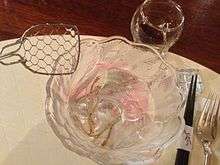Odorigui

Odorigui of ice gobies in Japan in April 2013
Odorigui ( 踊り食い, literally "dancing eating") is a mode of seafood consumption in Japanese cuisine.
Odorigui refers to the consumption of live seafood while it is still moving, or the consumption of moving animal parts.[1] Animals usually consumed in odorigui style include octopus, squids, ice gobies, and other similar animals. Consumption of live seafood without remarkable movements, such as sea urchins, is usually not included in odorigui.
Notable dishes
- Katsu ika odori don (活いか踊り丼) lit. "living squid dancing rice bowl"
See also
- Ikizukuri, the preparation of sashimi from living animals
- Odori ebi, shrimp eaten alive in Japanese cuisine
- Drunken shrimp, shrimp eaten alive in Chinese cuisine
- Sannakji, octopus eaten alive in Korean cuisine
- Yin Yang fish, partially deep-fried fish eaten alive in mainland China and Taiwanese cuisine
- Dojo nabe
References
- ↑ (Staff writers) (July 22, 2011). "Dancing squid bowl: Could you eat this?". Herald Sun. Retrieved 31 January 2014.
- 大辞林 第三版 from
- 踊り食い in Japanese Wikipedia
External links
- (Japanese) 活きイカ踊り丼を食べる女子アナハプニング
This article is issued from Wikipedia - version of the 11/26/2016. The text is available under the Creative Commons Attribution/Share Alike but additional terms may apply for the media files.